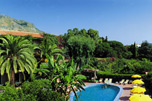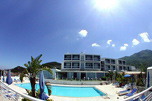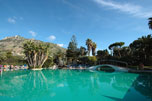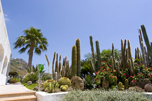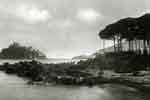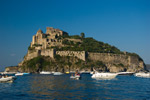The town of Ischia is located at the eastern point of the island, this municipality includes in its extension the villa in Campagnano to the ESE, the Villa de' Bagni to the NE; through these villages it borders in the south with the City of Testaccio, on the side Campagnano in the hills of St. Pancrazio. To the south-west of the territory of Barano to the Cremato on the Piejo campaigns. To the north with the town of Casamicciola, on the side towards the Villa de'Bagni, Cercola and Quercia.
The main center is located where once was the village of Gelso, the district so named because planted the mulberries in the shade of these trees in the summer days were the inhabitants of the city during the hours of walking.
That village was in ancient times inhabited by sailors and fishermen, who because of their job they could not normally remain hospitalized in the closed cities, but also could not get away for the frequent barbarian raids.
Pleasant countryside, fertile gardens, extending around this ancient town, which gradually saw rising buildings around the new buildings, more modest and not uncomfortable, but sumptuous and architectural, the result of the growing affluence of its inhabitants.
The population grew, the need of widening township grew larger, both houses, and other comfortable life structures.
Result of trade, by the class of sailors, was the increase of the Village of Mulberry, which soon turned into pulpy district, where they erected temples, monasteries, hospitals. Public fountains, plazas, marinas: the one from the south-east ELP class of fishermen, the other from the north-east of the class of sailors.
When the castle ended up being the city of the island, this village became the main center of the town, and established church authorities and island’s military.
This main center of Ischia extends over a large stretch of land, wet to the NE from the sea, for its entire length: from the opposite side is lined with decent and elegant buildings, behind which rise the rolling hills of Sorezzano Procidano and embellished with lovely mess. Ischia has a few internal roads: one is remarkable for its length and width and the principle of the bridge where took the head of the castle artificial isthmus and extends to the point so that terrazappata, where you turn right continue its course towards the Mandra, the cremated de'Bagni Villa. To the left it vanishes, after covering the quarter-Lauro House, in the narrow paths and country of S. James and Mandarin.
The Puzzolana street leads to Villa Campagnano, and the next campaign, to the municipalities of Testaccio, Barano, etc.
Spacious, comfortable and well-paved is the square of this town, it is the center of all operations, the place of delivery of all the peasants and the bourgeoisie, both living in the main town, is that ascend from the rural villages. Decent are most of the buildings of the town of Ischia.
The seminar was open to clerical education until 1806 and served for the neighborhood to the garrison of the square. It was reopened in 1844, was finally suppressed in 1865.
The best buildings on the road, are those of the lords Lauro, Califano, Lanfreschi, Moriconi, de Luca, Mirabella, and others under construction, or recent, or forgotten by us.
The main center is located where once was the village of Gelso, the district so named because planted the mulberries in the shade of these trees in the summer days were the inhabitants of the city during the hours of walking.
That village was in ancient times inhabited by sailors and fishermen, who because of their job they could not normally remain hospitalized in the closed cities, but also could not get away for the frequent barbarian raids.
Pleasant countryside, fertile gardens, extending around this ancient town, which gradually saw rising buildings around the new buildings, more modest and not uncomfortable, but sumptuous and architectural, the result of the growing affluence of its inhabitants.
The population grew, the need of widening township grew larger, both houses, and other comfortable life structures.
Result of trade, by the class of sailors, was the increase of the Village of Mulberry, which soon turned into pulpy district, where they erected temples, monasteries, hospitals. Public fountains, plazas, marinas: the one from the south-east ELP class of fishermen, the other from the north-east of the class of sailors.
When the castle ended up being the city of the island, this village became the main center of the town, and established church authorities and island’s military.
This main center of Ischia extends over a large stretch of land, wet to the NE from the sea, for its entire length: from the opposite side is lined with decent and elegant buildings, behind which rise the rolling hills of Sorezzano Procidano and embellished with lovely mess. Ischia has a few internal roads: one is remarkable for its length and width and the principle of the bridge where took the head of the castle artificial isthmus and extends to the point so that terrazappata, where you turn right continue its course towards the Mandra, the cremated de'Bagni Villa. To the left it vanishes, after covering the quarter-Lauro House, in the narrow paths and country of S. James and Mandarin.
The Puzzolana street leads to Villa Campagnano, and the next campaign, to the municipalities of Testaccio, Barano, etc.
Spacious, comfortable and well-paved is the square of this town, it is the center of all operations, the place of delivery of all the peasants and the bourgeoisie, both living in the main town, is that ascend from the rural villages. Decent are most of the buildings of the town of Ischia.
The seminar was open to clerical education until 1806 and served for the neighborhood to the garrison of the square. It was reopened in 1844, was finally suppressed in 1865.
The best buildings on the road, are those of the lords Lauro, Califano, Lanfreschi, Moriconi, de Luca, Mirabella, and others under construction, or recent, or forgotten by us.
The Aragonese Castle
The castle is made of a cone of lava basalt, which rises from the sea bottom, and is about 600 feet from its highest level. The truncated cone to the bottom, forms the south-east a less steep slope, covered with gardens, and the ruins of ancient cities, there for many years.
The old bishop’s palace, a convent, and the remains of public and private buildings, for many years abandoned and destroyed, most islanders do not live there, or bourgeois, because it conforms more part of the territory of Ischia, the place having become state property.
At the top of the fortress was headquartered healing of veterans, whose only nine have remained.
At the foot of the fortress there was once a battery above the water.
From the drawbridge, the first port gate, to the citadel, there is a climb of about a kilometer and 250 meters in the shape of spiral. Per length of 500 feet is dug into the rock, forming a gallery deck 22 feet in width, of high winds.
In the fifteenth century it was about impregnable fortress.
This castle was built by soldiers of Hiero, when the rebels drove out the Cumans, they were to occupy this island about the year 474 AEV. It was called Castel-Hiero, or Castel-Geronda and also the island of Hiero. It was then called Ischia and Ischia Minor.
In the beginning it was reachable by sea.
Castle fell into the hands of Alfonso I, who dug these chisels to power a street so wide that two chariots could meet: he rose all external communications, and from the outside covered with rocks and inaccessible cliffs, ditches , ramparts, walls and iron doors, calling it Castrum Regium Isclae.
Alfonso himself populated this enclosure in a colony consisting of 300 their exposures, to whom married women of expelled fighters. Since that time the fortress was called earth, or Citadel independent of City Island.
To make sure the nascent citadel, and linked to a stable island, Alfonso I, published in 1433 or 35 that royal edict, reported in the Second Part of that story, which established the customs mentioned: he made to join the Citadel to the Island, with an artificial isthmus, formed of solid bridges between the waves and the rocks, basalt stones to convert and guaranteed by cliffs, which was still needed to repair the small woods that stormy weather were in the bosom of the marina of St. Anna.
During the rule of the Aragonese, this royal castle has been illustrated by the facts of value, both the houses of noble and illustrious personages.
The Castle was when the city of the island, came to contain a population of 1892 families, as evidenced by Giovannandrea d’Aloysio, proceeds from the wealth of the kingdom in the year 1757.
Then there was all gathered, nobility, bourgeoisie, the clergy, ranks, authorities, public offices, churches, monasteries, cathedrals, shops. The island of Ischia was deserted and barren. In some beach or hill was gathered some villa, land or house, inhabited by peasants, or farmers, or traffickers, or fishermen, and a few landowners.
In the past century the inhabitants of the town of Ischia began to focus on the hill now known as Citizens of Casamicciola, and here raised these villas and cottages, mansions, and churches.
At the end of the eighteenth century all the inhabitants came out, the city was confused with the castle, and all that constituted the strength of Ischia, occupied by the garrison of veterans, sailors and gunners.
The old bishop’s palace, a convent, and the remains of public and private buildings, for many years abandoned and destroyed, most islanders do not live there, or bourgeois, because it conforms more part of the territory of Ischia, the place having become state property.
At the top of the fortress was headquartered healing of veterans, whose only nine have remained.
At the foot of the fortress there was once a battery above the water.
From the drawbridge, the first port gate, to the citadel, there is a climb of about a kilometer and 250 meters in the shape of spiral. Per length of 500 feet is dug into the rock, forming a gallery deck 22 feet in width, of high winds.
In the fifteenth century it was about impregnable fortress.
This castle was built by soldiers of Hiero, when the rebels drove out the Cumans, they were to occupy this island about the year 474 AEV. It was called Castel-Hiero, or Castel-Geronda and also the island of Hiero. It was then called Ischia and Ischia Minor.
In the beginning it was reachable by sea.
Castle fell into the hands of Alfonso I, who dug these chisels to power a street so wide that two chariots could meet: he rose all external communications, and from the outside covered with rocks and inaccessible cliffs, ditches , ramparts, walls and iron doors, calling it Castrum Regium Isclae.
Alfonso himself populated this enclosure in a colony consisting of 300 their exposures, to whom married women of expelled fighters. Since that time the fortress was called earth, or Citadel independent of City Island.
To make sure the nascent citadel, and linked to a stable island, Alfonso I, published in 1433 or 35 that royal edict, reported in the Second Part of that story, which established the customs mentioned: he made to join the Citadel to the Island, with an artificial isthmus, formed of solid bridges between the waves and the rocks, basalt stones to convert and guaranteed by cliffs, which was still needed to repair the small woods that stormy weather were in the bosom of the marina of St. Anna.
During the rule of the Aragonese, this royal castle has been illustrated by the facts of value, both the houses of noble and illustrious personages.
The Castle was when the city of the island, came to contain a population of 1892 families, as evidenced by Giovannandrea d’Aloysio, proceeds from the wealth of the kingdom in the year 1757.
Then there was all gathered, nobility, bourgeoisie, the clergy, ranks, authorities, public offices, churches, monasteries, cathedrals, shops. The island of Ischia was deserted and barren. In some beach or hill was gathered some villa, land or house, inhabited by peasants, or farmers, or traffickers, or fishermen, and a few landowners.
In the past century the inhabitants of the town of Ischia began to focus on the hill now known as Citizens of Casamicciola, and here raised these villas and cottages, mansions, and churches.
At the end of the eighteenth century all the inhabitants came out, the city was confused with the castle, and all that constituted the strength of Ischia, occupied by the garrison of veterans, sailors and gunners.






